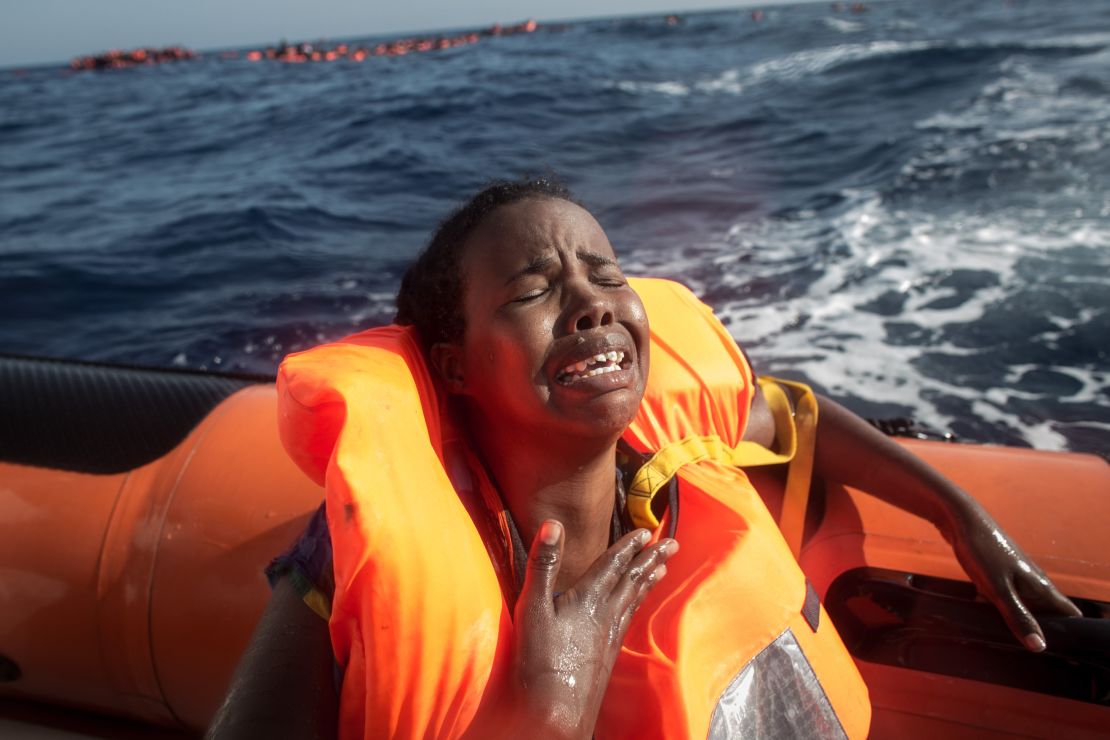Story highlights
MSF, MOAS, UNICEF urge action at G-7 on migrant issue
Boat partially capsized on Wednesday, killing 34 people
World leaders at the G-7 summit on Friday will meet in Sicily – a promised land for thousands of migrants making the desperate journey from North Africa to Europe.
This week, Italy received 4,513 migrants to the country. It was a 576% increase from the previous week, according to the International Organization for Migration. It could suggest that more migrants are attempting to cross the Mediterranean as the weather gets warmer – a pattern seen in previous years.
So far this year, Italy has received about 90% of the approximately 60,000 migrants who arrived to Europe by sea, according to the UN High Commisioner for Refugees data, updated this week.
Tragedy on ‘Europe’s doorstep

On Wednesday, a wooden boat carrying about 500 migrants was hit by a wave that caused passengers to rush to one side of the vessel, according to the Italian Coast Guard. This tipped about 200 people overboard into the Mediterranean. Thirty-four people died, said the Coast Guard.
Dramatic photos showed people in orange life vests bobbing in the water calling for help.
One man without a life jacket clung to the side of a boat as an Italian Coast Guard boat approached. “Come on, my friend!” one rescuer yelled at him. Rescuers reached out to him and pulled him to safety, as shown in a video released by the Italian Coast Guard. When the man was brought to safety, he sobbed uncontrollably as a rescuer embraced him.

Ships from the Italian Coast Guard, Great Britain, Spain and two NGOs – Doctors Without Borders and MOAS – worked to rescue about 1,800 migrants who were attempting to cross the Mediterranean Sea in four rubber boats and six wooden vessels.
Migrant Offshore Aid Station (MOAS) a private humanitarian organization, said that seven children died.

“There are no words for what is happening in the Central Mediterranean right now,” said Christopher Catrambone, founder of MOAS, in a statement. “It is a horrifying tragedy that continues to unfold on Europe’s doorstep.”
“MOAS is doing everything it can but alternative solutions must be found by Europe’s leaders if this continuing loss of life is to be mitigated,” he said.
Groups: Make humane migration policy
Other groups also called for the G-7 to commit to humane migration policies.
Several NGOs and UNICEF are urging leaders of the seven major economies to address the ongoing migrant crisis. President Donald Trump, German Chancellor Angela Merkel, French President Emmanuel Macron and Japanese Prime Minister Shinzo Abe will be in attendance in Taormina, Italy.
Dr. Joanne Liu, international president of Doctors Without Borders, also known as Médecins Sans Frontières, or MSF, called the rising deaths at sea “as a humanitarian failure on their watch.”
UNICEF estimates that at least 200 children have died trying to cross the Mediterranean into Italy this year.
“This is their [G7’s] moment to show true leadership in adopting a concrete policy plan that will help keep refugee and migrant children safe,” Justin Forsyth, UNICEF deputy executive director said in a statement.
What’s happened since 2015 crisis
In 2015, the number of migrants entering or attempting to enter Europe exploded in the largest migration since World War II. The unprecedented surge brought more than a million migrants and refugees into Europe that year.
In response, European countries began to curb their own refugee programs. Governments have sought to fortify their countries’ borders with fences, walls and guards against future mass migrations.
A deadly record was set in 2016 as at least 3,800 migrants died in the Mediterranean.
Meanwhile, migration into Greece from Turkey largely stopped after a controversial EU-Turkey deal in 2016. Ankara agreed to take back all, new migrants who leave Turkey’s shores for Europe including those intercepted in its territorial waters, on the condition that one legitimate Syrian refugee is resettled in Europe for every Syrian returned to Turkey.
After the deal went into effect, arrivals to Greece plummeted in 2016 while arrivals to Italy increased.
This year, Italy made a deal to bolster Libya’s coast guard so it could spot departing migrant boats and also house migrants attempting to cross.
Doctors Without Borders has been critical of both the EU-Turkey and Italy-Libya deals, slamming them as “outsourcing migration management to – often unsafe – third countries.”
Migrants arriving by sea this year has not been at the same level as that in 2015. Two years ago by May, 91,441 refugees and migrants had arrived to Europe by sea.
So far this year, 60,199 sea arrivals have been recorded, according to UNHCR data.
CNN’s Milena Veselinovic contributed to this report.






















